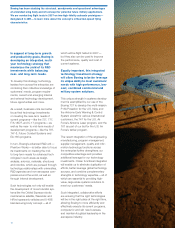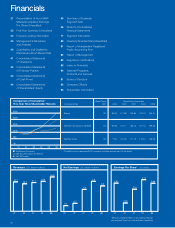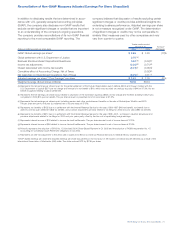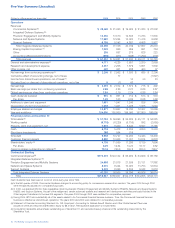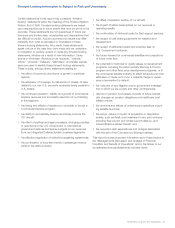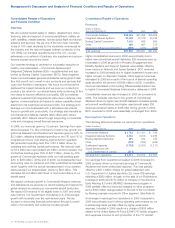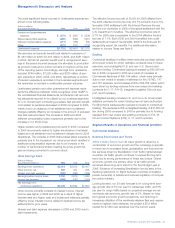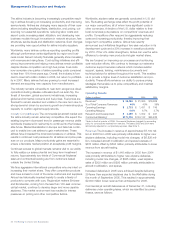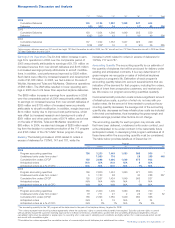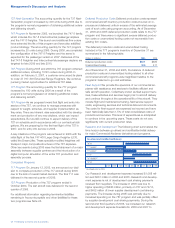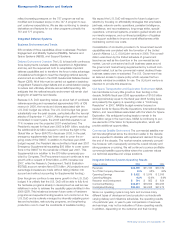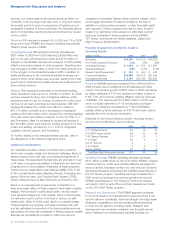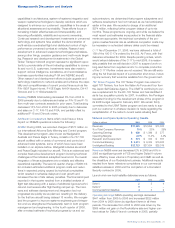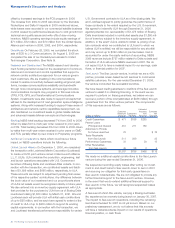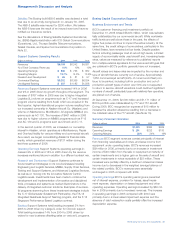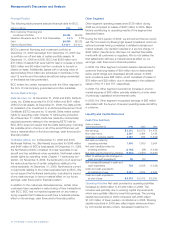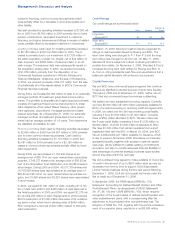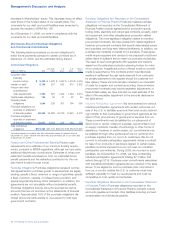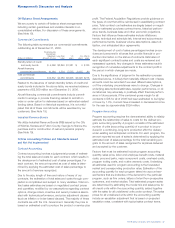Boeing 2006 Annual Report Download - page 29
Download and view the complete annual report
Please find page 29 of the 2006 Boeing annual report below. You can navigate through the pages in the report by either clicking on the pages listed below, or by using the keyword search tool below to find specific information within the annual report.
Earnings from Operations The $1,302 million increase in earn-
ings from operations in 2006 over the comparable period of
2005 was primarily attributable to earnings of $1,781 million on
increased revenue from new aircraft deliveries and $315 million
in increased earnings primarily attributable to aircraft modifica-
tions. In addition, cost performance improved by $226 million.
Such items were offset by increased research and development
costs of $1,088 million. In 2005, we had a loss on the sale of
Wichita, Kansas and Tulsa and McAlester, Oklahoma operations
of $68 million. The IAM strike resulted in lower operating earn-
ings in 2005 due to 29 fewer than expected airplane deliveries.
The $686 million increase in earnings from operations in 2005
over the comparable period of 2004 was primarily attributable
to earnings on increased revenue from new aircraft deliveries of
$265 million and $135 million of increased revenue primarily
attributable to aircraft modification. In addition, margin improved
$414 million mainly due to improved cost performance, which
was offset by increased research and development costs of
$361 million and other period costs of $174 million, and a loss
on the sale of Wichita, Tulsa and McAlester operations of
$68 million. In 2004, we also had charges of $280 million result-
ing from the decision to complete production of the 717 program
and $195 million of the 767 USAF Tanker program charge.
Backlog The backlog increase in 2006 related to orders in
excess of deliveries for 737NG, 747 and 787, while the
increase in 2005 related to orders in excess of deliveries for
737NG, 777 and 787.
Accounting Quantity The accounting quantity is our estimate of
the quantity of airplanes that will be produced for delivery under
existing and anticipated contracts. It is a key determinant of
gross margins we recognize on sales of individual airplanes
throughout a program’s life. Estimation of each program’s
accounting quantity takes into account several factors that are
indicative of the demand for that program, including firm orders,
letters of intent from prospective customers, and market stud-
ies. We review our program accounting quantities quarterly.
Commercial aircraft production costs include a significant amount
of infrastructure costs, a portion of which do not vary with pro-
duction rates. As the amount of time needed to produce the ac-
counting quantity decreases, the average cost of the accounting
quantity also decreases as these infrastructure costs are included
in the total cost estimates, thus increasing the gross margin and
related earnings provided other factors do not change.
The accounting quantity for each program may include units
that have been delivered, undelivered units under contract, and
units anticipated to be under contract in the reasonable future
(anticipated orders). In developing total program estimates all of
these items within the accounting quantity must be considered.
The table below provides details as of December 31:
The Boeing Company and Subsidiaries 27
Management’s Discussion and Analysis
717 737NG 747 757 767 777 Total
2006
Cumulative Deliveries 155 2,136 1,380 1,049 947 604
Deliveries 5(3)302* 14 – 12* 65 398
2005
Cumulative Deliveries 150 1,834 1,366 1,049 935 539
Deliveries 13(5)212* 13 2 10* 40 290
2004
Cumulative Deliveries 137 1,622 1,353 1,047 925 499
Deliveries 12(6) 202* 15 11 9(1) 36 285
*Intracompany deliveries were two 767 aircraft and eight 737 Next-Generation aircraft in 2006, two 767 aircraft and two 737 Next-Generation aircraft in 2005 and three
737 Next-Generation aircraft in 2004.
Program
717 737NG 747 757 767 777 787
2006
Program accounting quantities 156 3,200 1,449 1,050 985 900 *
Undelivered units under firm orders11,560 116 28 299 448
Cumulative firm orders (CFO)2155 3,696 1,496 1,049 975 903
Anticipated orders N/A N/A N/A N/A 8 N/A
Anticipated orders as a % of CFO N/A N/A N/A N/A 1%N/A
2005
Program accounting quantities 156 2,800 1,424 1,050 971 800 *
Undelivered units under firm orders15 1,123 58 30 288 287
Cumulative firm orders (CFO)2155 2,957 1,424 1,049 965 827
Anticipated orders N/A N/A N/A N/A 3 N/A
Anticipated orders as a % of CFO N/A N/A N/A N/A 0%N/A
2004
Program accounting quantities 156 2,400 1,400 1,050 959 700 *
Undelivered units under firm orders118 771 27 2 25 167 52
Cumulative firm orders (CFO)2155 2,393 1,380 1,049 950 666
Anticipated orders N/A 5 19 N/A 6 34
Anticipated orders as a % of CFO N/A 0% 1% N/A 1% 5%
* The accounting quantity for the 787 program will be determined in the year of first airplane delivery, targeted for 2008.
1Firm orders represent new aircraft purchase agreements where the customers’ rights to cancel without penalty have expired. Typically customer rights to cancel
without penalty include the customer receiving approval from its Board of Directors, shareholders, government and completing financing arrangements. All such
cancellation rights must be satisfied or expired prior to recording a firm order even if satisfying such conditions are highly certain. Firm orders exclude option aircraft
and aircraft with cancellation rights.
2Cumulative firm orders represent the cumulative number of commercial jet aircraft deliveries plus undelivered firm orders.



